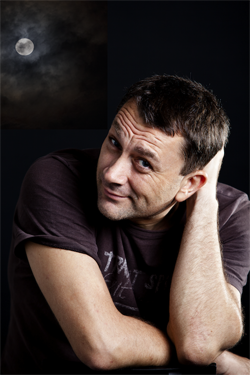Highlights
CQT's Dagomir Kaszlikowski guest blogs for Scientific American

Why is the moon's behaviour different to that of a quantum particle? Dagomir's group has come up with a new approach to explaining how the classical world emerges from the quantum.
|
|
How does the everyday, classical world emerge from the strange behaviour of its quantum constituents? Writing for the Scientific American Guest Blog, CQT's Dagomir Kaszlikowski (pictured) describes a new explanation proposed by his group and its collaborators.
Quantum particles can show behaviour more strongly coordinated (known as EPR correlations) than we see in the macroscopic world. Nor do we encounter in the classical world the fundamental unpredictability of quantum measurement outcomes.
Conventionally, quantum physicists point to 'decoherence' as the destroyer of these quantum properties. The idea of decoherence is that interactions with the surroundings gradually wash the quantumness out of a system – a process that would happen much faster for a large object containing many interacting particles than for small systems.
"Interestingly, our explanation for how the classical world arises from the quantum world does not invoke 'decoherence' or any of the other mechanisms proposed before," writes Dag in his Scientific American blog post. Instead, his group argues, it comes down to what's observable statistically for large numbers of particles. Read Dag's post for an excellent non-technical description. The technical details are in the groups' two papers, the first a paper published 3 August in Physical Review Letters and the second a preprint uploaded to arXiv.org on 11 November.
Scientific American's Guest Blog describes itself as providing a forum for perspectives in science and technology that "readers would find thought-provoking, fascinating, debatable and challenging".
Dagomir is a CQT Principal Investigator and an Associate Professor at NUS. His coauthors on the first paper are CQT researchers Ravishankar Ramanathan; Tomasz Paterek; Alastair Kay, who is also affiliated with the University of Oxford, UK; and Pawel Kurzyniski, who is also affiliated with the Adam Mickiewicz University, Poland. On the second paper, co-authors Pawel and Ravishankar are joined by CQT's Akihito Soeda and Andrzej Grudka, who is also affiliated with the Adam Mickiewicz University, Poland, and Jayne Thompson of the University of Melbourne, Australia.
The two references are "Local Realism of Macroscopic Correlations" Phys. Rev. Lett. 107, 060405 (2011); arXiv:1010.2016 and "Emergence of non-contextuality in macroscopic systems" arXiv:1111.2696.






